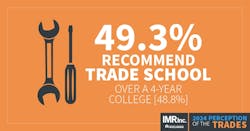Survey: Aircraft Maintenance and Repair Remains Most Recommended Trade Career
Heads up, aviation organizations looking for maintenance talent: Recruiting the young people you want and need for the future might be easier than you think.
That’s one of the main takeaways from the newly released Perception of the Trades survey of nearly 25,000 households’ attitudes to having a child or other family member start a career in the trades. Nearly three out of five survey respondents who were discussing possible career paths told Endeavor Business Intelligence that they would be ‘extremely likely’ to recommend an aircraft maintenance career to young people.
The 59% figure was by far the highest ‘extremely likely’ response among more than a dozen career paths and right in line with aircraft maintenance’s score in the 2023 Perception of the Trades report. The trade coming in second by the ‘extremely likely’ measure was automotive technician at nearly 46% while a career as a brick mason was rated third at 40%.
“Certainly, each of these trades has a unique attraction,” Rob Pietrowsky, vice president of research and business intelligence at Endeavor unit IMR, said. “Aviation has a status attached to it that explains the higher interest. However, the outlook for the auto tech profession seems to be changing, in part due to well-known vehicle advancements. It’s becoming more of specialized technology profession.”
For the 2024 edition of Perception of the Trades, Endeavor Business Intelligence researchers asked household members about 14 trades ranging from aircraft and auto technicians to brick masons, electricians and crane operators. Among households surveyed that were discussing career options, 79.5% of respondents said they would be extremely likely to recommend a trade if that’s an option a child or family member was considering.
That is a significant increase from 72.9% in 2023 and a strong signal that trade careers are growing their appeal in a tight labor market and in the face of rising costs for a traditional college education. But while that general recommendation score rose smartly, the average score of the 14 industries EBI asked about was a little less than 37%, essentially unchanged from 2023’s number.
While the general sentiment around a career in the trades is positive, the average score per industry being static suggests people do not fully understand which specific trades are most in demand and/or what skills are needed for those roles. There may indeed be a halo effect around the idea of a trade career but it appears many don’t have a clear understanding of the specifics.
While the idea of a trade career is gaining traction, there is still work to be done in helping people understand the details of these paths and the demand for certain skills.
“This discrepancy highlights the need for better communication and education about the opportunities in individual trades,” IMR Senior Analyst Anthony Shaheen said. “The lower industry-specific scores show that while the idea of a trade career is gaining traction, there is still work to be done in helping people understand the details of these paths and the demand for certain skills.”
Some other findings that surfaced from Perception of the Trades include:
- Also speaking to the fact that filling the skills gap isn’t going to get easier for most industries: Young adults’ interest in immediately entering the workforce after high school has dropped to 25% from 33.8% in 2022.
- The COVID-19 pandemic has improved people’s overall perception of trade careers: More than 68% of respondents said they now see such a career “much more” favorably than in 2020 and another 13.2% said their perception has become “slightly more favorable.”
- Rural households remain more inclined to recommend the trades—55.9% did so this year versus nearly 62% in 2022—but suburban residents have become much more optimistic about the prospect of a trade career. Two years ago, less than 42% of that cohort recommended the trades. This time around, that number had jumped to 50.1%.
The need to educate both generations
Mikaela Gitto, director of human resources at Wisconsin-based Sentry Equipment, said a key to converting that general interest into actual hires is spending time on educating both generations involved in career choices. It’s not just about speaking to young people with an enthusiasm for trade work but also about speaking to parents who might still view the trades as dangerous and/or dirty and long ago placed a high priority on college educations.
“But so much has changed from a couple of decades ago,” said Gitto, who helps managers recruit for openings Sentry has in the Badger State as well as at locations in the Salt Lake City and Houston areas. “Plants are cleaner, safer and use much more robotics. That’s really appealing to young people.”
Sentry, which makes sampling and automation equipment as well as machinery used by wastewater and oil and gas companies, also invests time and energy in programs that help convey Gitto’s message. In addition to regularly hosting tours of high school students, it has partnered with GPS Education Partners, a nonprofit that has built work-based learning programs that function a lot like community colleges’ dual-enrollment programs.
Gitto said Sentry takes on interested students, some as young as sophomores, on part-time paid internships and trains them in numerous roles at its plants over the course of several months. The company has hired several of the students that have come to it via the partnership with GPS.
Payoffs like that are possible for many companies, said Paul Mattioli, executive vice president of Endeavor Business Intelligence—particularly if they’re sustained over time and can build word-of-mouth referrals. A broad foundation—a generally positive view of working with your hands—is there to build on.
“This latest wave of our research shows a continuing trend of improving sentiment around the trades,” Mattioli said. “That’s great news for the companies struggling to attract talented young men and women to start careers in their specialties.”
To download the full “Perception of the Trades” report, click here.
About the Author
Geert De Lombaerde
Senior Editor
A native of Belgium, Geert De Lombaerde has been in business journalism since the mid-1990s and joined Endeavor Business Media in 2021 to write about public companies, markets and economic trends for various Endeavor Business Media publications. He also curates the twice-monthly Market Moves Strategy newsletter that showcases Endeavor stories on strategy, leadership and investment and contributes to other Market Moves newsletters.
After earning a degree in journalism from the University of Missouri, Geert began his reporting career at the Business Courier in Cincinnati and was later editor of the Nashville Business Journal and the Nashville Post.



